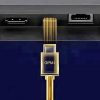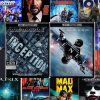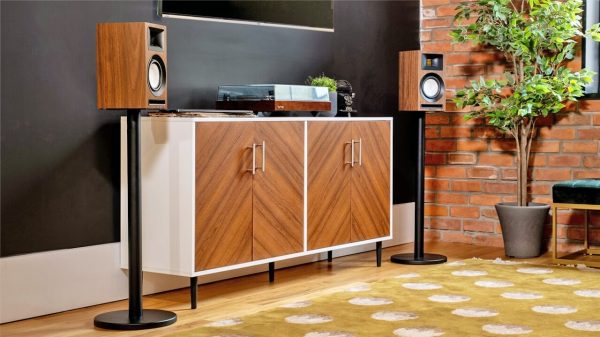It’s almost too easy to recommend the Bluesound NODE as the hub of any system because there is a lot more below the surface that most users won’t consider using.
The NODE is one of the most comprehensive streamers with support for MQA, all of the major streaming services, AirPlay 2, voice control through Amazon Alexa, and comes equipped with an internal 32-bit/192kHz DAC.
That last part is important because it means that you can run the NODE directly into a preamp, integrated amplifier, or pair of powered/active loudspeakers as a source — no secondary DAC required.
The new NODE carries over the TOSLINK and Coaxial digital outputs from the previous Node 2i streamer, but I was more curious about the addition of a USB digital output for the first time. Bluesound and NAD have included USB on other components but they’ve only been used previously for firmware updates.
There have been promises before about USB on the NODE so I’m not commenting on its performance until Bluesound enable it with a firmware update.

The NODE now features an HDMI eARC input on the back panel, to keep your setup flexible and future-friendly. Designed to be as comfortable in a two-channel TV system or as it is in an audiophile’s dedicated listening room, the NODE provides a hi-res experience no matter where it’s used.
Wi-Fi connectivity, a Gigabit Ethernet RJ45 input, and support for two-way Bluetooth 5.0 aptX HD makes the NODE a very comprehensive solution for most users.
This Roon-ready device also plays well in the sandbox with other ecosystems aside from BluOS and sounds decidedly analog for a digital component. New compatibility with Tidal Connect is just additional icing on your Vachon cake.
Advanced controls, including tone controls, subwoofer crossover optimization, and settings to enhance external DAC connections are available in the BluOS Controller app.
The Bluesound NODE definitely has a sonic signature; I’ve grown tired of audiophiles bombarding me with emails that take exception to the concept that not every digital device sounds the same.
“It’s only zeroes and ones…”
“I’ve tricked other audiophiles with my blind listening experiment and they couldn’t tell..”
If they all sound the same, then why do they all measure differently?
Do all DACs sound the same? Output stages? Multi-bit sounds like R-2R?
That’s not the case.
Does the Andover Songbird sound the same as the Bluesound NODE? I own both and use them daily — they don’t sound the same at all through the same amplifier/speakers.
The more I listen to music through the NODE and try it with active/powered loudspeakers, the more I see its long-term value for a much wider range of listeners.
You can use the NODE through its analog outputs (fixed or variable) with speakers like the Kanto TUK, Acoustic Energy AE1, and Fluance Ai61 with great results.
The Kanto TUK comes with an internal MM phono preamp which is not offered on the AE1 or Ai61 Powered Loudspeakers.
Make Mine a Panzerotti

Growing up in Toronto, I was rich with panzerotti options (just not at my parent’s pizzeria which was sadly ironic) and I’ve yet to find one here in the Garden State which loves its calzones. The “baked” versus “fried” debate will go on forever but I’m firmly in the deep fried panzerotti camp for a myriad of reasons; crunchy exterior layer, the ability to wrap one and eat while walking in the blustery cold, the savory blend of melted cheese, pepperoni, and grease can’t be beat.
The Fluance Audio Ai61 are another savory treat from north of the border for only $299.99 USD.
The Ai61 are a powered two-way bookshelf loudspeaker featuring a 1-inch silk dome tweeter, and 6.5-inch woven glass fiber driver. The two loudspeakers share a 120 watt/channel Class D power amplifier (only one loudspeaker is active while the other is passive) and Fluance supplies a rather basic remote control to control the volume and input selection.
There is Bluetooth 5.0 support but you’re not going to use that with the NODE acting as the digital hub.
There is also a subwoofer output on the Ai61 loudspeakers but you’re not going to use that either.
You can adjust the crossover settings in BluOS and limit what the NODE outputs to the Ai61 loudspeakers (between 40Hz and 200Hz) with its subwoofer mode enabled. You then connect your subwoofer to the subwoofer output on the NODE and that limits what the Ai6i has to reproduce below whatever crossover point you select.
The Ai61 will sound clearer and less strained at higher listening levels. It’s buried within BluOS and something that I’ve been using with multiple speakers and a subwoofer.
Bluesound NODE: $599.00 at Amazon
Fluance Audio Ai61 Powered Loudspeakers: $299.99 at Amazon
SVS SB-1000 Pro: $599.99 at Amazon
Total: $1,498.98 USD
Phở Đuôi Bò

There’s nothing like a fragrant bowl of Pho with Oxtail on a cold winter day in Montreal or Toronto. It really hits the spot. My local place here on the Shore does it really well but I suspect I’m the only one who orders it because of the free serving of Vietnamese Spring Rolls that always arrives even when I don’t want a second order. It’s clearly a gift for my long-standing patronage and appreciation of the joy that is fatty oxtail in the broth.
I like the meaty nature of the oxtail and how it interacts with the noodles and a few squirts of Grandma’s hot sauce. It has a lot of texture and never disappoints.
Very much like the underrated Kanto TUK Powered Loudspeakers.
Kanto is another Canadian brand that has focused on affordable loudspeakers for years and I’m a huge fan. I’ve owned a pair of TUK for almost 2 years and they work exceptionally well with both music and movies in our living room.

Kanto has built a steady reputation offering affordable active loudspeakers that support both digital and analog sources like a turntable. The brand, however, faces stiff competition from its rivals over at Audioengine so it was only a matter of time before someone introduced a higher-end model designed to offer consumers a complete solution with few compromises below $800. Enter the TUK. Ribbon tweeters have been utilized in higher priced loudspeakers for many years, but there is a growing movement at the entry-level to integrate them into bookshelf loudspeakers as they offer a superior level of detail and airiness that conventional tweeters fail to deliver.
The TUK’s feature an AMT tweeter, and 5.25-inch aluminum midrange woofer that produce a very rich, yet detailed presentation. The TUK can play very loudly, but our listening suggests that the treble can sound a little hot when you do; they are particularly adept with electronic music, pop, and hip-hop. Kanto has wisely chosen to integrate a MM phono stage, USB DAC, headphone amplifier, and support for Bluetooth aptX HD making the TUK one of the most complete active loudspeaker packages available at any price.
The optional stands should be considered mandatory, as well as the matte white finish which looks very sleek.
The TUK have dramatically more impact than the Fluance Ai61 (they should considering the price difference) and they are better suited for movies without a subwoofer if that is not in the budget. The internal MM phono preamp is actually quite usable and a good match with entry-level carts from Ortofon, Grado, Nagaoka, and Audio-Technica.
The NODE/TUK combination is not inexpensive but it’s capable of far more resolution, and the bass response is tighter, deeper, and much quicker.
The TUK also reproduces scale far more convincingly than the powered Fluance loudspeakers and Bluetooth performance is more consistent when streaming TIDAL or Qobuz from your smartphone.
The supplied loudspeaker cable could be slightly longer but it’s better quality and I’ve felt zero need to try other audiophile speaker cables in-between both speakers.
The Andover Audio SpinDeck Max is so much better than their base model it’s almost hard to recommend the more affordable version. I’ve been using it with the TUK and Fluance Ai61 speakers and it’s obvious that it wasn’t made in China and has been problem free from the unboxing.
The U-Turn Orbit+ with the Ortofon UM5E (versus the OM10 on the SpinDeck Max) is slightly cheaper and also a very good option here.

The TUK don’t need a subwoofer in a small-medium sized room but the addition of the SVS 3000 Micro Subwoofer takes this system to another level in terms of its low end performance and the range of the TUK when they don’t have to reproduce the bottom octaves. If you’re looking for a very robust sounding 2.1 system for a living room or den, the TUK/SVS 3000 Micro combination will not disappoint with the Bluesound NODE handling all of the digital streaming.
Bluesound NODE: $599 at Amazon
Kanto TUK: $899.99 at Amazon
Andover Audio SpinDeck Max ($599) or U-Turn Orbit+ ($469)
SVS 3000 Micro Subwoofer: $899.99 at Amazon
Total: $2,997.98 USD
Berg’s Classic Poutine with Smoked Meat

Berg’s of Belmar recently transitioned from a food truck in Asbury Park and those of us on the Shore with a deep love affair for Montreal Smoked Meat, and classic Poutine on fries with gravy are feeling a tad spoiled this morning. If you’ve never sampled the fatty meat from Montreal on some rye bread with a side order of greasy fries smothered in hot gravy with a Cott’s Black Cherry — you’re clearly not friends with any cardiologists.
I’m not recommending that anyone partake in deli more than once or twice a month because it’s really not that healthy, but Berg’s fills a badly needed void here on the Jersey Shore. There are 75,000 Jews alone here in Monmouth County and not having a deli is more suffering than one should be forced to endure.

The intensity of the flavors just works and it definitely makes quite an impression; just like the Acoustic Energy AE1 active loudspeakers that were my favorite product to review in 2021.
All active loudspeakers are “powered” by nature (some are even naughty ;-)) but not all powered loudspeaker are active.
The Acoustic Energy AE1 ($1,390) are active loudspeakers because they feature separate power amplifiers inside each loudspeaker; both the tweeter and midrange driver/woofer have their own amplifiers, active crossovers, and do not require a connection to the other in order to work.
The AE1 feature 4 x 50 watt/channel class AB power amplifiers and offer no form of DSP.
You are tied to the sound of the power amplifiers but that’s a very good thing in this case.
These are not wireless loudspeakers, but they will work quite effectively in the context of a wireless digital streaming system.
Each loudspeaker has its own volume control (there is no remote) on the real panel of each cabinet; the placement is somewhat awkward so just leave them turned all the way up and forget that they exist.
It’s fine.
Each loudspeaker features both single-ended and balanced input jacks. I didn’t find the difference between them enormous but if you have a pre-amplifier, network streamer, or DAC with balanced outputs – try them both and see which one sounds better to your ears.
From a tonal perspective, the AE1 are definitely on the neutral side. Nobody will call them warm sounding. Some people may find them a tad cool for their tastes.
Which is perfectly fine because you completely change how they sound based on your choice of pre-amp, source, or DAC.
They are also very dynamic sounding loudspeakers that certainly like to reach out and touch you.
Bass response is first-rate with these active loudspeakers. Bass is tight, articulate, and I am inclined to believe the quoted 42Hz – 28kHz (+/- 6dB) frequency response. In a very large room, you might want to add a subwoofer, but I was more than satisfied in my office (35’ x 13’ x 9’) listening space.
Bluesound NODE: $599.00 at Amazon
Acoustic Energy AE1: $1,590.00 (pair)
Pro-Ject Phono Tube Box DS2: $699.00
Rega Planar 3/Nagaoka MP-110: $1,147.00
Total: $3,835.00








































